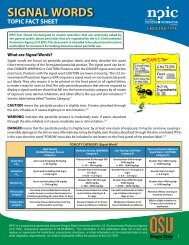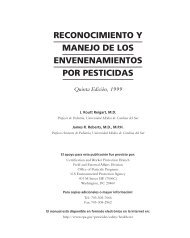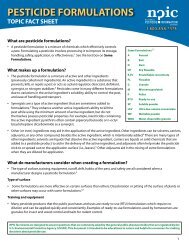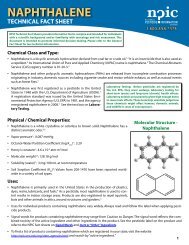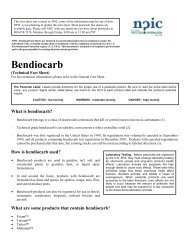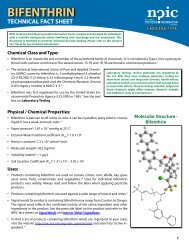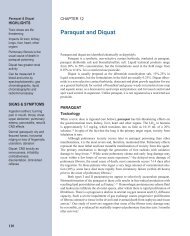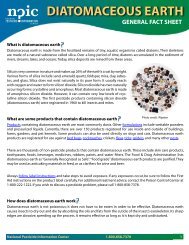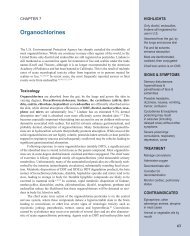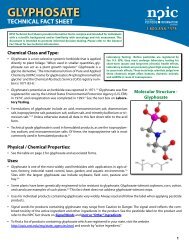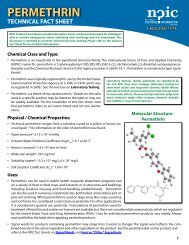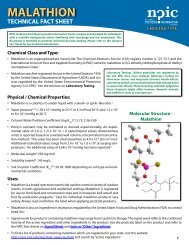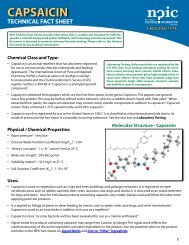Solid Organochlorine Insecticides
Solid Organochlorine Insecticides
Solid Organochlorine Insecticides
You also want an ePaper? Increase the reach of your titles
YUMPU automatically turns print PDFs into web optimized ePapers that Google loves.
HIGHLIGHTS<br />
Muscarinic, nicotinic, CNS<br />
effects<br />
Absorbed by inhalation,<br />
ingestion, skin<br />
Lipophilic<br />
Poisonings tend to be of<br />
shorter duration than OPs<br />
SIGSSTS<br />
Malaise, muscle weakness,<br />
dizziness, sweating<br />
May include blurred vision,<br />
incoordination, muscle<br />
twitching, slurred speech<br />
May include headache,<br />
salivation, nausea, vomiting,<br />
abdominal pain, diarrhea<br />
Blood cholinesterase levels<br />
not reliable indication<br />
Severe symptoms may<br />
include coma, seizures,<br />
hypotonicity, hypertension,<br />
cardio/respiratory<br />
depression<br />
TTT<br />
Ensure clear airway<br />
Administer atropine<br />
Decontaminate concurrently<br />
Consider pralidoxime in<br />
mixed poisonings<br />
Consider GI<br />
decontamination<br />
TIIT<br />
Adrenergic amines without<br />
specic indication e.g.,<br />
hypotension)<br />
CHAPTER 6<br />
<br />
<br />
<br />
The N-methyl carbamate esters cause reversible carbamylation of acetylcholinesterase<br />
(AChE) enzyme, allowing accumulation of acetylcholine, the neuromediator<br />
substance, at parasympathetic neuroeffector junctions (muscarinic effects), at skeletal<br />
muscle myoneural junctions and autonomic ganglia (nicotinic effects) and in the<br />
brain (CNS effects). The carbamyl-acetylcholinesterase combination dissociates more<br />
readily than the phosphoryl-acetylcholinesterase complex produced by organophosphate<br />
compounds. This lability has several important consequences: (1) it tends to<br />
limit the duration of N-methyl carbamate poisonings, (2) it accounts for the greater<br />
difference between symptom-producing and lethal doses than exists in the case of<br />
most organophosphate compounds and (3) it frequently invalidates the measurement<br />
of blood cholinesterase activity as a diagnostic index of poisoning (see below).<br />
Carbamates are absorbed by inhalation, ingestion and through the skin, although<br />
the last tends to be the less-toxic route. For example, carbofuran has a rat oral LD 50<br />
of 5 mg/kg, compared to a rat dermal LD 50<br />
of 120 mg/kg, which makes the oral route<br />
approximately 24 times more toxic when ingested. 1 The LD 50<br />
is only one measure<br />
of pesticide toxicity. The dose must also be considered since a compound with a<br />
high LD 50<br />
can produce life-threatening symptoms if a large enough dose is ingested.<br />
N-methyl carbamates are hydrolyzed enzymatically by the liver, and the degradation<br />
products are excreted by the kidneys and the liver.<br />
At cholinergic nerve junctions with smooth muscle and gland cells, high<br />
acetylcholine concentration causes muscle contraction and secretion, respectively.<br />
At skeletal muscle junctions, excess acetylcholine may be excitatory (cause muscle<br />
twitching), but may also weaken or paralyze the cell by depolarizing the end-plate.<br />
In the brain, elevated acetylcholine concentrations may cause sensory and behavioral<br />
disturbances, incoordination, seizures and depressed motor function including lethargy<br />
and coma. 2,3,4 The N-methyl carbamates are lipophilic and penetrate the central<br />
nervous system as evidenced by distribution throughout all tissues including the brain<br />
on post mortum. 5,6 Respiratory depression combined with pulmonary edema is the<br />
usual cause of death from poisoning by N-methyl carbamate compounds.<br />
<br />
As with organophosphate poisoning, the signs and symptoms are based on excessive<br />
cholinergic stimulation. Carbamate poisonings tend to be of shorter duration than<br />
organophosphate poisonings because of the reversibility of the AChE binding and the<br />
more rapid metabolism of carbamates. 7 However, as mentioned in the next section of<br />
this chapter, blood cholinesterase levels may be misleading because of in vitro reactivation<br />
of a carbamylated enzyme. 8,9 This falsely normal or near-normal level can make<br />
the diagnosis more difcult in the acute presentation in the absence of an exposure<br />
history.<br />
56
Malaise, muscle weakness, dizziness and sweating are commonly reported<br />
early symptoms. Miosis with blurred vision, incoordination, muscle twitching and<br />
slurred speech are reported. Headache, salivation, nausea, vomiting, abdominal pain<br />
and diarrhea are often prominent. Transient hyperbilirubinemia may occur. 10 Acute<br />
pancreatitis has also been reported in some of the cases of aldicarb and methomyl<br />
poisoning. Some cases of pancreatitis have required surgical drainage of a pancreatitic<br />
pseudocyst. 3,11,12,13<br />
The most severe manifestations of carbamate poisoning occur in the respiratory<br />
and central nervous (CNS) systems. CNS ndings include coma, seizures and hypotonicity,<br />
and nicotinic effects including hypertension and cardiorespiratory depression.<br />
The respiratory depression also results from skeletal muscle impairment in which<br />
the chest wall cannot expand for adequate respiration. Dyspnea, bronchospasm and<br />
bronchorhea with eventual pulmonary edema are other serious signs. 3,14 Data indicate<br />
that children and adults differ in their clinical presentation. Children are more likely<br />
than adults to present with the CNS symptoms above. While children can develop<br />
the classic muscarinic signs, the absence of them does not exclude the possibility of<br />
carbamate poisoning in the presence of CNS depression. 2,4,15,16<br />
<br />
If there are strong clinical indications of acute N-methyl carbamate poisoning, and/or<br />
a history of carbamate exposure, treat the patient immediately. Do not wait for laboratory<br />
conrmation.<br />
Blood for plasma pseudocholinesterase and RBC AchE should be obtained.<br />
Unless a substantial amount of N-methyl carbamate has been absorbed and a blood<br />
sample is taken within an hour or two, it is unlikely that blood cholinesterase activities<br />
will be found depressed. Even under the above circumstances, a rapid test for enzyme<br />
activity must be used to detect an effect, because enzyme reactivation occurs in vitro<br />
as well as in vivo.<br />
Absorption of some N-methyl carbamates can be conrmed by analysis of<br />
urine for unique metabolites; alpha-naphthol from carbaryl, isopropoxyphenol from<br />
propoxur, carbofuran phenol from carbofuran, and aldicarb sulfone, sulfoxide and<br />
nitrile from aldicarb. These complex analyses, when available, can be useful in identifying<br />
the responsible agent and following the course of carbamate disposition.<br />
TIT<br />
CAUTION: Persons attending the victim should avoid direct contact with<br />
heavily contaminated clothing and vomitus. Wear rubber gloves while washing<br />
<br />
1. Ensure that a clear airway exists. Intubate the patient and aspirate the secretions<br />
with a large bore suction device if necessary. Administer oxygen by mechanically<br />
assisted pulmonary ventilation if respiration is depressed. Improve tissue oxygenation<br />
as much as possible before administering atropine, so as to minimize the risk<br />
of ventricular brillation. In severe poisonings, it may be necessary to support<br />
pulmonary ventilation mechanically for several days.<br />
2. Administer atropine sulfate intravenously or intramuscularly if intravenous<br />
injection is not possible. Atropine can be administered in small volume doses<br />
through an endotracheal tube if initial I access is difcult to obtain. Carba-<br />
CHAPTER 6<br />
N-Methyl Carbamates<br />
IL<br />
TS<br />
Highly Toxic 1<br />
aldicarb (Temik)<br />
aminocarb 2 (Matacil)<br />
bendiocarb 2 (Ficam, Dycarb,<br />
Multamat, Niomil, Tattoo,<br />
Turcam)<br />
carbofuran (Furadan)<br />
cloethocarb 2 (Lance)<br />
formetanate (Carzol)<br />
isolan 2 (Primin)<br />
methiocarb (Mesurol)<br />
methomyl (Lannate, Nudrin)<br />
oxamyl (Vydate L, DPX<br />
1410)<br />
Moderately Toxic 1<br />
bufencarb 2 (Metalkamate,<br />
Bux)<br />
carbaryl (Sevin, Dicarbam)<br />
dimetan 2 (Dimethan)<br />
dioxacarb 2 (Elecron, Famid)<br />
isoprocarb 2 (Etrofolan,<br />
MIPC)<br />
pirimicarb 2 (Pirimor, Abol,<br />
Acida, Aphox, Fernos,<br />
Rapid)<br />
promecarb 2 (Carbamult)<br />
propoxur (Aprocarb,<br />
Baygon, various ea/tick<br />
products)<br />
trimethacarb 2 (Landrin,<br />
Broot)<br />
1<br />
“Highly toxic” N-methyl carbamates<br />
have listed oral LD 50<br />
values (rat)<br />
less than or equal to 50 mg/kg body<br />
weight; “moderately toxic” agents<br />
have LD 50<br />
values in excess of 50<br />
mg/kg and less than 500 mg/kg.<br />
2<br />
Products no longer registered in<br />
the United States.<br />
57
CHAPTER 6<br />
N-Methyl Carbamates<br />
mates may reverse with smaller dosages of atropine than those required to reverse<br />
organophosphates, though the required dosage is still considerably larger than<br />
that required to atropinize a non-poisoned patient. 17,18 A common dosing pitfall<br />
is giving too little atropine initially to achieve timely atropinization. Severely<br />
poisoned individuals may exhibit remarkable tolerance to atropine and require<br />
large doses. 14 (See dosage below.)<br />
The objective of atropine antidotal therapy is to antagonize the effects of<br />
excessive concentrations of acetylcholine at end-organs having muscarinic receptors.<br />
Atropine does not reactivate AChE or accelerate excretion or breakdown<br />
of carbamate. Multiple doses of atropine may be necessary, as recrudescence of<br />
poisoning can occur if tissue concentrations of toxicant remain high when the<br />
antidotal effect wears off. Atropine is effective against muscarinic manifestations,<br />
but is ineffective against nicotinic actions, specically muscle weakness and<br />
twitching, and respiratory depression. Despite these limitations, atropine is often<br />
a lifesaving agent in N-methyl carbamate poisonings.<br />
Reassess the clinical situation after an adequate loading dose has been given.<br />
If symptoms persist, but the history is consistent with carbamate poisoning, then<br />
continue atropine therapy. However, if the clinical picture is unclear, clinicians<br />
should reassess and consider alternative causes of poisoning, such as pyrethroid<br />
insecticide poisoning, which may present a similar clinical picture.<br />
In moderately severe poisoning (hypersecretion and other end-organ manifestations<br />
without central nervous system depression) the following dosage<br />
schedules have proven effective:<br />
<br />
<br />
I 1-3 mg IV. Repeat in 3-5 minutes if no<br />
change in clinical symptoms. Dose may be doubled with<br />
each administration until the patient is atropinized. Once<br />
adequate atropinization has been achieved, the patient can<br />
be maintained on an atropine continuous infusion at about<br />
10%-20% of the loading dose and titrated to effect. 18,19,20,21<br />
Clear breath sounds and absent pulmonary secretions<br />
are the primary end point. Other signs of atropinization<br />
<br />
tachycardia (pulse of 140 per minute) may occur. Early in<br />
therapy, monitor for improving blood pressure and heart<br />
rate (above 80 beats/ minute), normal pupil size and drying<br />
of the skin and axillae. 20,21 Autoinjectors containing 2.0 mg<br />
atropine for IM injection are also available.<br />
WARNING: Poisonings in which liquid carbamate pesticide<br />
concentrates have been ingested may be complicated by hydrocarbon<br />
aspiration. Pulmonary edema and poor oxygenation in these cases<br />
will not respond to atropine and should be treated as a case of acute<br />
respiratory distress syndrome.<br />
continued next page<br />
58
CHAPTER 6<br />
N-Methyl Carbamates<br />
Dosage of Atropine, continued<br />
<br />
I 0.02 mg/kg body weight IV. As with<br />
adults, double the dose every 5 minutes until pulmonary<br />
secretions are controlled. Consider continuous infusion at<br />
10%-20% of the required loading dose and titrate. Signs of<br />
<br />
and heart rates vary depending on age of child, with young<br />
toddlers having a rate approaching 200. Crackles in the lung<br />
bases nearly always indicate inadequate atropinization,<br />
and pulmonary improvement may not parallel other signs.<br />
Continuation of, or return of, cholinergic signs indicate the<br />
need for more atropine.<br />
Reversal of muscarinic manifestations, rather than a specic dosage, is the<br />
object of atropine therapy.<br />
NOTE: Persons not poisoned or only slightly poisoned by N-methyl carbamates<br />
may develop signs of atropine toxicity from large doses, such as fever, muscle<br />
<br />
clinical effects, atropine administration should be discontinued, at least<br />
temporarily, while the severity of poisoning is reevaluated.<br />
3. Save a urine sample for metabolite analysis if there is need to identify the agent<br />
responsible for the poisoning.<br />
4. Consider pralidoxime in cases of mixed carbamate/organophosphate poisoning<br />
and cases of an unknown pesticide with muscarinic symptoms on presentation<br />
(see Chapter 5, Organophosphate <strong>Insecticides</strong>, subsection Treatment, item 5,<br />
page 49. 22,23 Pralidoxime has been used in some cases of carbamate poisoning,<br />
although other cases have resolved from supportive care alone. 24,25 Pralidoxime is<br />
probably of little value in N-methyl carbamate poisonings and is not indicated in<br />
isolated carbamate poisonings. Atropine alone usually is effective.<br />
5. Decontaminate concurrently with whatever resuscitative and antidotal measures<br />
are needed to preserve life. Contamination of the eyes should be removed by<br />
ushing with copious amounts of clean water. For asymptomatic individuals who<br />
are alert and physically able, skin decontamination should occur as previously<br />
outlined in Chapter 3, General Principles. Specically, skin and hair should be<br />
washed with soap and water. Attending personnel must take precautions including<br />
rubber gloves to avoid contamination. Contaminated clothing should be promptly<br />
removed, bagged and laundered before returning, and items such as shoes, boots<br />
and headgear should be discarded.<br />
6. Consider gastrointestinal decontamination if N-methyl carbamate has been<br />
ingested in a quantity sufcient to cause probable poisoning. If the patient has<br />
presented with a recent ingestion and still asymptomatic, adsorption of poison<br />
with activated charcoal may be benecial. If the patient has already vomited or<br />
59
CHAPTER 6<br />
N-Methyl Carbamates<br />
is symptomatic, which is highly likely in signicant poisonings, attention should<br />
be placed on oxygen, airway management and atropine. In signicant ingestions,<br />
diarrhea and/or vomiting are so constant that charcoal adsorption and catharsis<br />
are not included.<br />
7. Observe patient closely for at least 24-48 hours to ensure that symptoms (sweating,<br />
visual disturbances, vomiting, diarrhea, chest and abdominal distress, and sometimes<br />
pulmonary edema) do not recur as atropinization is withdrawn. The observation<br />
period should be longer in the case of mixed pesticide ingestion, because of<br />
the prolonged and delayed symptoms associated with organophosphate poisoning.<br />
As the dosage of atropine is reduced over time, check the lung bases frequently<br />
for crackles. Atropinization must be reestablished promptly if crackles are heard<br />
or if there is a return of miosis, sweating or other signs of poisoning.<br />
8. Monitor pulmonary ventilation carefully, particularly in poisonings by large doses<br />
of N-methyl carbamates, even after recovery from muscarinic symptomatology,<br />
to forestall respiratory failure.<br />
9. Monitor cardiac status in severely poisoned patients by continuous ECG recording.<br />
10. Give adrenergic amines (n-morphine, succinlycholine, theophylline, phenothiazines<br />
and reserpine) only if there is a specic indication, such as marked hypotension.<br />
Otherwise, they are probably contraindicated in N-methyl carbamate<br />
poisoning cases.<br />
11. Treat cases in which liquid concentrates of some carbamates formulated in a<br />
petroleum product base have been ingested as acute respiratory distress syndrome.<br />
Hydrocarbon aspiration may complicate these poisonings. Pulmonary edema and<br />
poor oxygenation in these cases will not respond to atropine.<br />
12. Do not administer atropine prophylactically to workers exposed to N-methyl<br />
carbamate pesticides. Prophylactic dosage may mask early symptoms and<br />
signs of carbamate poisoning and thus allow the worker to continue exposure<br />
and possible progression to more severe poisoning. Atropine itself may enhance<br />
the health hazards of the agricultural work setting, impairing heat loss (due to<br />
reduced sweating) and impairing the ability to operate mechanical equipment due<br />
to blurred vision caused by mydriasis.<br />
60
References<br />
CHAPTER 6<br />
N-Methyl Carbamates<br />
1. Micromedex I. Registry of Toxic Effects of Chemical Substances: NIOSH; 1991.<br />
2. Lifshitz M, Shahak E, Bolotin A, Sofer S. Carbamate poisoning in early childhood and in<br />
adults. J Toxicol Clin Toxicol. 1997;35(1):25-27.<br />
3. Ragouc-Sengler C, Tracqui A, Chavonnet A, et al. Aldicarb poisoning. Hum Exp Toxicol.<br />
2000;19:657-662.<br />
4. Zwiener RJ, Ginsburg CM. Organophosphate and carbamate poisoning in infants and children.<br />
Pediatrics. Jan 1988;81(1):121-126.<br />
5. Tsatsakis AM, Bertsias GK, Mammas IN, Stiakakis I, Georgopoulos DB. Acute fatal<br />
poisoning by methomyl caused by inhalation and transdermal absorption. Bull Environ<br />
Contam Toxicol. Apr 2001;66(4):415-420.<br />
6. Yamazaki M, Terada M, Kuroki H, Honda K, Matoba R, Mitsukuni Y. Pesticide poisoning<br />
initially suspected as a natural death. J Forensic Sci. Jan 2001;46(1):165-170.<br />
7. Echobichon DJ. Toxic effect of pesticides. In: Klaassen CD, ed. Casarett & Doull’s Toxicology:<br />
The Basic Science of Poisons. 5th ed. New York: McGraw-Hill; 1996:659.<br />
8. Jokanovic M, Maksimovic M. Abnormal cholinesterase activity: understanding and interpretation.<br />
Eur J Clin Chem Clin Biochem. Jan 1997;35(1):11-16.<br />
9. Rotenberg M, Almog S. Evaluation of the decarbamylation process of cholinesterase<br />
during assay of enzyme activity. Clin Chim Acta. Sep 15 1995;240(2):107-116.<br />
10. Saadeh AM. Metabolic complications of organophosphate and carbamate poisoning. Trop<br />
Doct. Jul 2001;31(3):149-152.<br />
11. Brahmi N, Blel Y, Kouraichi N, Abidi N, Thabet H, Amamou M. Acute pancreatitis subsequent<br />
to voluntary methomyl and dichlorvos intoxication. Pancreas. Nov 2005;31(4):424-<br />
427.<br />
12. Rizos E, Liberopoulos E, Kosta P, Efremidis S, Elisaf M. Carbofuran-induced acute<br />
pancreatitis. JOP. Jan 2004;5(1):44-47.<br />
13. Weizman Z, Sofer S. Acute pancreatitis in children with anticholinesterase insecticide<br />
intoxication. Pediatrics. Aug 1992;90(2 Pt 1):204-206.<br />
14. Nelson LS, Perrone J, DeRoos F, Stork C, Hoffman RS. Aldicarb poisoning by an<br />
illicit rodenticide imported into the United States: Tres Pasitos. J Toxicol Clin Toxicol.<br />
2001;39(5):447-452.<br />
15. Lifshitz M, Shahak E, Sofer S. Carbamate and organophosphate poisoning in young children.<br />
Pediatr Emerg Care. Apr 1999;15(2):102-103.<br />
16. Verhulst L, Waggie Z, Hatherill M, Reynolds L, Argent A. Presentation and outcome of<br />
severe anticholinesterase insecticide poisoning. Arch Dis Child. May 2002;86(5):352-355.<br />
17. Goswamy R, Chaudhuri A, Mahashur AA. Study of respiratory failure in organophosphate<br />
and carbamate poisoning. Heart Lung. Nov-Dec 1994;23(6):466-472.<br />
18. Perera PM, Shahmy S, Gawarammana I, Dawson AH. Comparison of two commonly<br />
practiced atropinization regimens in acute organophosphorus and carbamate poisoning,<br />
doubling doses vs. ad hoc: a prospective observational study. Hum Exp Toxicol. Jun<br />
2008;27(6):513-518.<br />
19. Eddleston M, Buckley NA, Checketts H, et al. Speed of initial atropinisation in signicant<br />
organophosphorus pesticide poisoning--a systematic comparison of recommended regimens.<br />
J Toxicol Clin Toxicol. 2004;42(6):865-875.<br />
20. Eddleston M, Dawson A, Karalliedde L, et al. Early management after self-poisoning with<br />
an organophosphorus or carbamate pesticide - a treatment protocol for junior doctors. Crit<br />
Care. Dec 2004;8(6):R391-397.<br />
21. Roberts DM, Aaron CK. Management of acute organophosphorus pesticide poisoning.<br />
BMJ. Mar 24 2007;334(7594):629-634.<br />
61
CHAPTER 6<br />
N-Methyl Carbamates<br />
22. Kurtz PH. Pralidoxime in the treatment of carbamate intoxication. Am J Emerg Med. Jan<br />
1990;8(1):68-70.<br />
23. Lifshitz M, Sofer S, Shahak E, Rotenberg M, Almog S, Tamiri T. Carbamate poisoning<br />
and oxime treatment in children: a clinical and laboratory study. Pediatrics. Apr<br />
1994;93(4):652-655.<br />
24. Park CH, Kim KI, Park SK, Lee CH. Carbamate poisoning: high resolution CT and pathologic<br />
ndings. J Comput Assist Tomogr. Jan-Feb 2000;24(1):52-54.<br />
25. CDC. Poisonings Associated with Illegal Use of Aldicarb as a Rodenticide — New York<br />
City, 1994–1997. MMWR Morb Mortal Wkly Rep. 1997;46(41):961-963.<br />
62




